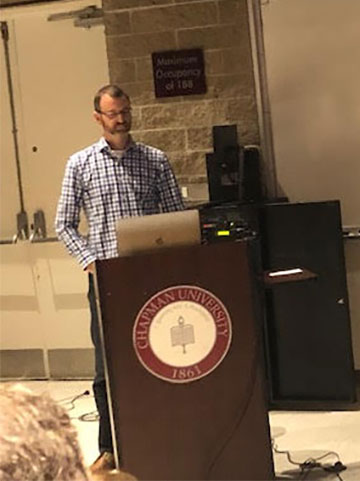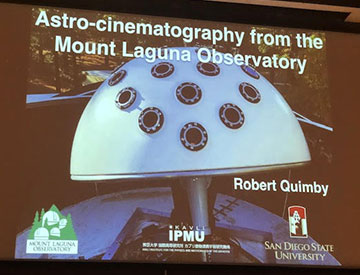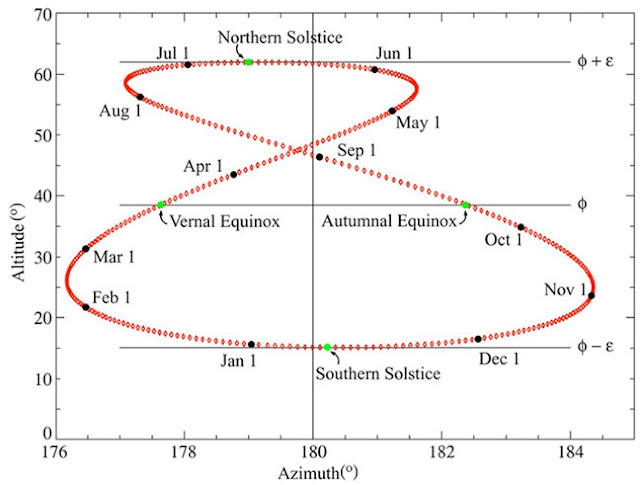Well this is a great time for finding most of the planets all arranged pretty close together. So after trying to look at some of the planets we will delve into OCA featured speaker at Mt. Laguna Observatory used publicly available images to excite student's interest in astronomy and Analemma in particular.
So this is the time of year when most of the planets are observed to be very close together in the night sky. The following DSLR image captures Venus and Saturn in the night sky. The exposure was set to 5 seconds so that the background stars would also show up. You can also see some high clouds. What are the two red "eyes" in the palm tree?
 |
| Venus and Saturn in this DSLR image, 210 mm, ISO 800, 5 seconds (Source: Palmia Observatory) |
Using this image and Astrometry.net, we can then identify some of the other background stars as part of the Sagittarius grouping of stars.
 |
| Using Astrometry.net to plate solve for pointing at Sagittarius (Source: Palmia Observatory) |
Later on in the month we will find most of the planets all pretty much lined up. Although Mercury will be below the horizon when the sun sets, if you are lucky you still might see Jupiter very near the sun with Saturn, Pluto, Venus, Neptune and Uranus higher up along the ecliptic. I'm not sure if I will go after these planets or not, especially Pluto which would require going to a dark sky location, but the opportunity is before us. In the meantime, we can still put the camera on the moon, just past full moon timing. The moon is so bright that a very short, 1/4000 second, exposure time was called for. Also, with my lightweight, flimsy camera tripod, just making any kind of focus change caused the tripod to wobble wildly and it took half a dozen seconds for the thing to settle down.
 |
| Just passed full moon image with DSLR, 300 mm telephoto, 1/4000 second (Source: Palmia Observatory) |
While many star gazers don't like moon lit nights, for me, now on Friday the 13th, the light of the moon is a welcome sight to illuminate the shadows if you are going to be out and about. It turns out that this is the night for the OCA general meeting, so we can be out and have a good safe time there. This month's meeting had a presentation by Robert Quimby from SDSU. Professor Quimby spoke on Astro-cinematography form the Mount Laguna Observatory.
 |
| Professor Quimby, SDSU, speaks on astrophotography at Mount Laguna Observatory (Source: Palmia Observatory) |
In his introductory slide below you can see the all sky camera that is one of the instruments at the observatory.
 |
| Professor Robert Quimby, SDSU, is featured OCA general meeting speaker (Source: Palmia Observatory) |
Professor Quimby showed some images of the telescopes operated by SDSU on Mt. Laguna and it reminded me of the time that we tried to visit Mt. Laguna while we were at the 2015 Star Festival in Julian. The gates to the observatory where closed and we chose not to walk around the gates, so it was nice to see the photos that Quimby provided. If you want the rest of the story of our time in Julian and our trial visit Mt. Laguna, you can check out the August 18, 2015 blog post at:
http://www.palmiaobservatory.com/2015/08/julian-star-party-mendini-winery.html
 |
| Some of the observatories on Mount Laguna (Source: Robert Quimby, SDSU) |
Anyway Professor Quimby showed some interesting videos that he had compiled using publicly available images of the sky near the horizon. One of his videos a composite of 365 positions of the sun, each taken at the same time of the day. Because the orbit of the Earth around the sun is an ellipse and not a perfect circle, it does not move with same velocity and moves faster when the orbit brings it closer to the sun. Then if you draw the observed azimuth and elevation for the year of observations you get a figure called the analemma. You have probably seen this figure eight type of figure on many globes, although on my office terrestrial globe, purchased over forty years ago, does not have an analemma on it.
 |
| Analemma on a globe (Source: Wikipedia) |
Professor Quimby showed actual data obtained from publicly available cameras and how you can observe and track the apparent motion of the sun. I couldn't get a good photo of his presentation slide but this image from Wikipedia shows the same effect. If you take an image of the sun's location everyday of the year from the same physical location and at the same time of day, you get the figure eight pattern shown below. Quimbly hoped to use something like this observational plan as a study tool to excite beginning astronomy students. Hmm, I maybe could do something like that; just take one photo per day. How about you?
 |
| Composite image showing sun position over the course of a year (Source: Wikipedia) |
The Analemma can be plotted with dates and astronomical solstices to show the relationship between the end points of the figure eight.
 |
| Annotated Analemma with time of year and solstices (Source: Royal Observatory, Greenwich) |
Finally, after all of this hard work, this Resident Astronomer is ready for a nap. I didn't realize that while I napped, Astronomer Assistant Ruby was also napping, but at the same time performed her ritual chore of cleaning my Ipad! Hmm, I'm not sure if I should thank Resident Astronomer Peggy for capturing this afternoon (non)activity or not?
 |
| Hmm, I didn't know that Astronomer Assistant Ruby cleaned my Ipad while we both napped? (Source: Palmia Observatory) |
Until next time,
Resident Astronomer George
Be sure to check out over 300 other blog posts on similar topics
If you are interested in things astronomical or in astrophysics and cosmology
Check out this blog at www.palmiaobservatory.com

No comments:
Post a Comment